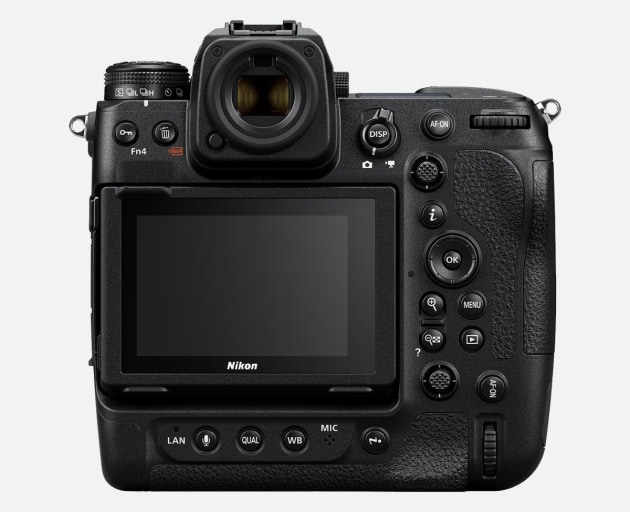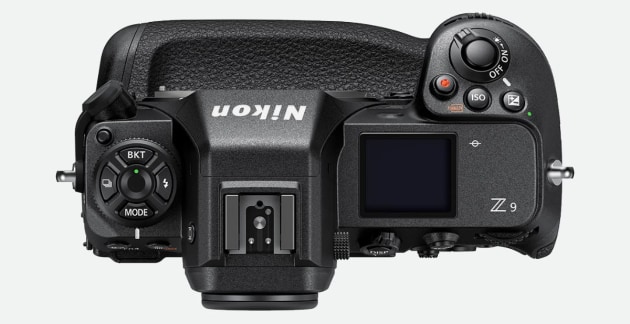Nikon announces Z 9: 45.7MP, 30fps shooting and 8K video
Nikon has officially announced the Z 9, the company's newest full-frame pro sports mirrorless camera.
The Z 9 is Nikon’s first full-frame mirrorless camera built without a mechanical shutter, which Nikon says allows it to shoot with the world’s least rolling shutter distortion.
Combine this with its fast-readout, stacked 45.7MP CMOS sensor, 30fps shooting and 8K/30p capture, and the Z 9 looks to be a real statement of intent from the Japanese company, and quite possibly the 'halo' product many Nikon shooters have been waiting for.

Body
Likely familiar to many sports shooters, the Z 9 keeps with the large format and slightly angular style borrowed from the Z-cameras. Unlike these though, it features a newly-designed 'multi-directional' 3.2-inch rear-LCD that uses a cradle-type system to allow it to move both horizontally and vertically, while keeping the screen centered.
This means regardless of whether you're shooting in portrait or landscape, the rear-LCD can be displayed in the correct orientation - very trick.
The Z 9's EVF is a 3.69M dot panel that Nikon says makes full use of this resolution for the camera's liveview (and not just playback). And finally, most of the Z 9s buttons are back-lit, and can be illuminated when you're trying to operate the camera in dark conditions - a feature we wish more camera manufacturers would implement.

The sensor
The stacked 45.7MP CMOS sensor in the Z 9 delivers the fastest readout rate of any full-frame camera, resulting in a flash sync speed of 1/200s. With the same megapixels as the Z 7, it's likely that the sensor is very similar, although its fast readout speeds suggests Nikon has further enhanced its capabilities.
The advantage of a stacked sensor is typically around burst rate and readout speed, but it also means AF processing can occur faster, with Nikon saying that the combination of the Stacked CMOS sensor and the faster data throughput of the Z mount allows the camera to process and communicate 120 AF calculations per second, a key requirement for many sports photographers.
Another Nikon first is the addition of i-TTL balanced fill-flash, where face information is applied for flash control. This technology takes the human subject’s face into consideration and controls the volume of light to be fired appropriately when flash is used to avoid overexposure in shots.

Autofocus
Like the Canon R3, the Z 9 is capable of tracking humans, animals and vehicles, but the Autofocus differs from its rivals by not requiring the user to determine the subject in advance. In the camera's Auto mode, the Z 9 will assess a scene for any of the types of subjects it can recognise, although according to Nikon there are also settings that can be tweaked to ensure the camera doesn't pick the wrong subject.
Nikon's excellent 3D tracking technology also returns, and should perform like it does on the company's DSLRs.

The Nikon Z 9 can shoot bursts of JPEGs at up to 30 frames per second, the same as the Sony A1 and Canon EOS R3 (although this camera is lower resolution). Plus, if you're willing to sacrifice megapixels, the Z 9 can fire away at 120 fps JPEG shooting at 11MP resolution.
Raw maxes out at a still considerable 20 frames per second, and Nikon says the camera's buffer can shoot for over 1000 frames. That stacked sensor also means no blackout in any shooting mode, and Nikon has a,so implemented two new High Efficiency (HE) formats that compress the camera's RAW files to help manage storage.
Video
At launch, the Z 9 offers very competitive video specs that likely leverage the large 45.7MP sensor. Video maxes out at 8K/30p, but there's also oversampled 4K (from 8K) at up to 30p, or 4K/120p taken from the full width of the sensor. The Z 9 also becomes the first Nikon camera to be able to capture Log footage internally, and a firmware update in 2022 will enable internal Raw video capture at up to 60p.
Other features
The Z 9 features two CFexpress Type B slots which are backwards-compatible with XQD. It also uses the EN-EL18d battery, but will also work with all previous EN-EL18 batteries from ay of Nikon's other pro cameras.
Speaking of the battery, Nikon says the Z 9 can deliver 740 shots per charge if you use the rear LCD and 700 with the viewfinder. When it comes to bursts, the rate is much higher, with Nikon claiming the Z 9 is capable of capturing 5310 shots when shooting bursts before you'll need to swap out the battery.
As you'd expect, the Z 9 features Wi-Fi built-in, and there's also functionality with both wired and wireless LAN. Nikon says the new NX MobileAir and new NX Tether features allow for stable image transfers via a USB cable, and NX MobileAir to a smart device while uploading immediately to an FTP server of choice.
Availability
The Nikon Z 9 will be available this year, and is available for pre-order ow for $8,999 AUD.
At the same time, the company has also announced the release of two new lenses, the NIKKOR Z 100-400mm f/4.5-5.6 VR S, the first super-telephoto zoom lens in the NIKKOR Z S-Line, and a lens Nikon is calling the lightest in its class. It will be available from mid-December for $4,299. This has been anounced alongside the NIKKOR Z 24-120mm f/4 S, which will retail for $1,749.

And finally, if that's not enough, Nikon has confirmed it is working on a ew prime lens, the NIKKOR Z 400mm f/2.8 TC VR S super-telephoto prime with a built-in 1.4x teleconverter.
For more information on the Z 9, check out nikon.com.au/nikon-z9.


